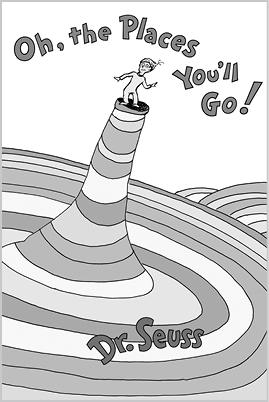Oh, the Places You’ll Go!
DR. SEUSS/THEODORE GEISEL
Reviewed by Todd

A number of years ago we got a substantial order for Oh, the Places You’ll Go! from one of our corporate customers. When we received subsequent orders, we became curious. What would an international manufacturer need with such a supply of Dr. Seuss books? A call to the company’s HR department revealed to us that they were using the book in their new-employee orientation.
While your employer may never have presented you with a copy, perhaps you received the book as a graduation present or at a baby shower. And perhaps you are wondering what on earth Oh, the Places You’ll Go! is doing on a list of must-read business books. If you haven’t cracked open your copy for a while, take this opportunity to pull it from the bottom shelf of your bookcase, where it is probably wedged between an old geometry textbook and a dog-eared atlas. Here’s why.
Oh, the Places You’ll Go! was published in 1990 and was Theodore Geisel’s (aka Dr. Seuss) last book. The book spent its first two years on the New York Times best-seller list, and Geisel remarked, “This proves it. I no longer write books for children. I write books for people.”
It is this book’s broad appeal and keen effectiveness that demands its mention here. Jack and I often say that we have seen the same book regurgitated dozens of times, just between different covers. To watch how many times a subject has been covered or a cliché has been reanimated can be disheartening. What keeps you coming back to some, however, is the magic that’s created when an idea and the way it is packaged conveys new (and true) meaning.
Oh, the Places You’ll Go! is self-help at its finest—self-help in the same way that Thoreau and Emerson championed self-improvement on the individual level. The book couldn’t begin on a more positive note:
Congratulations!
Today is your day.
You’re off to Great Places!
You’re off and away!
At just under six hundred words, the book covers the gamut of human experience. Our unnamed young man is told that choice is within his power and that all he has to do is decide. But deciding requires judgment and is not without consequence. Seuss points him to the less-traveled path because “there things can happen and frequently do.”
It is the reality of the negatives that makes the book so believable and motivating. Confusion, loneliness, and procrastination all make appearances. Each is a challenge, but Seuss never doubts that our little man will get through his difficulties. Geisel said the only thing all of his books had in common was hope, and Oh, the Places You’ll Go! will provide you with a healthy dose to face each new experience or disappointment that lies on your path.
“And will you succeed?
Yes! You will, indeed!
(98 and ¾ percent guaranteed.)”
Many nights I find myself reading this book to my children. I am not sure if its frequent appearance at bedtime is for them or for me. I do know that this book taps into the ideal that we can all be better people and help make the world a better place for us and for our children. Every book should deliver on such a promise. TS
Oh, the Places You’ll Go!, Random House, Hardcover 1990, ISBN 9780679805274
WHERE TO NEXT?
 See the next page for more
business books for all ages.
See the next page for more
business books for all ages.